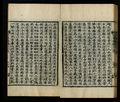(Translation) 李睟光 外國4
| Primary Source | ||
|---|---|---|
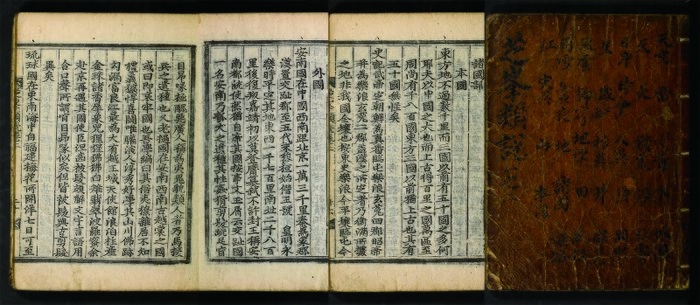 |
Title | |
| English | ||
| Chinese | 芝峯類說 | |
| Korean(RR) | 지봉유설(Jibongyuseol) | |
| Text Details | ||
| Genre | Literati Writings | |
| Type | ||
| Author(s) | 李睟光 | |
| Year | ||
| Source | ||
| Key Concepts | ||
| Translation Info | ||
| Translator(s) | Participants of 2018 Summer Hanmun Workshop (Advanced Translation Group) | |
| Editor(s) | ||
| Year | 2018 | |
Introduction
Original Script
| Image | Text | Translation |
|---|---|---|
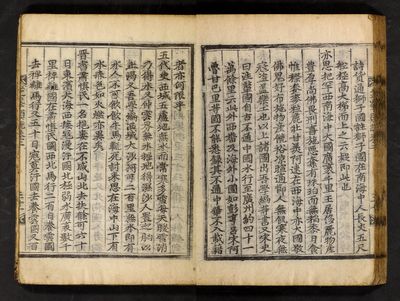
|
36. 亦思把罕。西南海中大國。廣袤千里。王居侈麗。物産豐厚。尚佛畏刑。喜施惡奪。有珠珀而無稻黍。日食惟穄麥。麥粒麤壯甘美。阿速在西海中。亦大國。敬佛鬼好布施。物産饒裕。凉暄適節。人無飢寒。夜無寇盜。蓋樂土也。以上諸國。出吾學編等書。又宋史曰。注輦國。自古不通中國。水行至廣州。約四十一萬餘里云。此外西番及海外小國。如彭亨,呂宋,阿魯甘,巴里等國。不能悉錄。其不通中華。不入載籍者。亦何限乎。 37. 五代史。西域五盧地無水。而常寒多雪。每天暖雪消。乃得水。又仲雲界無水。掘地得濕沙。人置之胸以止渴。又吾學編。西域大沙河可二百里無水。卽有水。人不可飮。飮牛馬輒死。討來思在海中。山下有水。赤色如火燃。亦異矣。 38. 晉書。肅愼氏。一名挹婁。在不咸山北。去扶餘可六十日。東濱大海。西接寇漫汗國。北極弱水。廣袤數千里。裨離國。在肅愼氏國西北。馬行二百日。養雲國。去裨離馬行又五十日。寇莫汗國。去養雲國又百 |
37. In the History of Five Dynasties (五代史), five lands of Lu 盧[1] in the Western region “have no water, are always cold and have lots of snow. Every time the weather gets warm, the snow disappears and water is obtained from this."[2] The Zhongyun 仲雲[3] region has no water, either. One can get moist sand by digging the ground, which he can place on the chest to quench thirst. Also in Zheng Xiao's (鄭曉, 1499-1566) “Wuxuebian“ 吾學編 (ca. 1522), the great sand river of the West can be 200-li without water. Even if there is water, people cannot drink it. Feeding it to horses and cattle will always kill them. Taolaisi 討來思 is located in the middle of the sea. There is water beneath the mountain that is red in color like burning fire. This is also unusual. 38. In the Book of Jin (晉書), the Sushen 肅愼 tribe, Yilou 挹婁 by another name, resides at the north of Buxian 不咸 Mountain. Going there from Buyeo 扶餘 can take sixty days. To the East, it is adjacent to the great sea. To the West, it shares borders with Koumanhan 寇漫汗 state. To extreme north is Ruoshui 弱水. The area is thousands of [square] li. The state of Bei’er 裨離 is located to the northwest of the state of Sushen. By horse it takes 200 days. The state of Yangyun 養雲 is another 50-day distance by horse from Bei'er. The state of Kou-Mohan is another 100-day distance from the state of Yangyun 養雲.
|
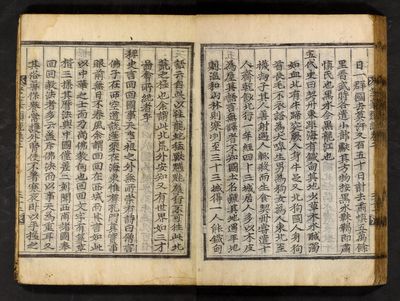
|
日。一群國。去莫汗又百五十日。計去肅愼五萬餘里。晉武時各遣小部。獻其方物。按黑水靺鞨。卽肅愼氏也。黑水。今黑龍江也。 39. 五代史曰。契丹東距海有鐵甸。其地少草木。水鹹濁如血。北有牛蹄突厥。人身牛足。又北狗國。人身狗首。長毛不衣。語爲犬嗥。生男爲狗女爲人。東北至襪劫子。其人善射。遇人輒殺而生食。契丹嘗遣十人。齎乾麨北行一年。經四十三城。居人多以木皮爲屋。其語言無譯者。不知國土名號。其地遇平地則溫和。山林則寒冽。至三十三城。得一人能鐵甸語云。自此以往。龍蛇猛獸魑魅群行。不可往。此北荒之極也。余謂此北荒外。安知又有世界。如三才圖會所紀者乎。 40. 稗史言回回國。事天事祖之外。無所崇。有詩曰僧言佛子在西空。道說蓬萊在海東。惟有孔門眞實事。眼前無日不春風。余謂回回在西域。而其言如此。以中華之士。而乃尚佛敎何也。回回文字。有篆草楷三樣。其曆法與中國僅差二刻。聞西南諸國。奉回回敎法者多云。蓋斥佛法而以事天爲重耳。又其俗善保養。常護外腎。使不着寒。夜臥以手握之 |
The state of Yiqun 一群 is another 50-day distance from Mohan. Estimated distance from Shushen is over 50,000 li. During the reign of Jin Wudi (266-290), they each dispatched Xiaobu 小部 to pay tributes of local products. Adjacent to Mohe 靺鞨 of Hesui 黑水 (Black Water) is the Sushen 肅愼 tribe. Hesui is today’s Helungjiang (Black Dragon River). 39. It says in the History of the Five Dynasties, “In the sea to the east of Khitan 契丹 is Tiedian 鐵甸. ... Its land has little plants. The water is salty and dirty as blood.”[4] “To the north there are Niuti Tujue 牛蹄突厥 (Ox-hoof Turks), with human bodies and ox-hooves.” [5] ”And in the Gouguo 狗國 (Dog-land) in the north, [people] have human bodies and dogs’ heads, are long haired and unclothed. Their language is a canine haul. At birth, the men become dogs and women become humans.” [6] ”To the northeast, one reaches Wajieji 襪劫子—its people are good archers. If they meet a person, they immediately kill him and eat him raw.”[7] "Khitan had dispatched ten people. Carrying dry barley powder, they traveled north for one year, past forty-three cities. Many residents used barks of trees for housing. As there was no interpretor of their language, the names of the country were unknown. Their land bordering the plane was temperate and [the land bordering] the forest was cold and chilly. When they reached thirty-third city, they got one man who could speak Tiedian language. ‘From this point on, even a group of dragons, serpents, birds of prey, and chimei 魑魅 will not be able to go [any further].' Its north is an extremity of wasteland.” I call this the Northern steppes (北荒外: lit., ”beyond the northern wasteland”). How could one know there is another world there? Such is what is recorded in Sancai tuhui 三才圖會. |
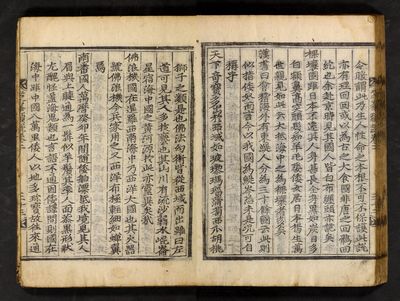
|
令暖。謂此乃生人性命之本根。不可不保護。此說亦有理。回回或以爲古之大食國。非唐之回鶻,回紇也。余赴京時。見其國人。皆白布纏頭。亦詭矣。 41. 裸壤國。距日本不遠。其人身甚長。全身黑如炭。目多白。額鼻高突。頭髮如羊毛。娶倭女居日本。楊生萬世親見如此云。大抵海中之爲裸壤者多矣。 42. 漢書曰。會稽海外。有東鯷人。分爲三十餘國云。此則似指倭奴而言。今以我國爲鯷岑。恐未是。況可自稱乎。 43. 天下奇寶。多出於西域。如玻瓈瑪瑙葡萄西瓜胡桃獅子之類是也。佛法幻術。皆從西域而出。雖曰左道。可見其人多技藝也。其山川。有流沙,弱水,崑崙,星宿海。中國之黃河源於此。亦靈異矣哉。 44. 佛浪機國。在暹羅西南海中。乃西洋大國也。其火器號佛浪機。今兵家用之。又西洋布極輕細。如蟬翼焉。 45. 南番國人。萬曆癸卯年間。隨倭舶漂抵我境。見其人。眉與上睫通爲一。髯似羊鬚。其率人面漆黑。形狀尤醜怪。蓋海鬼類也。言語不通。因倭譯問。則國在海中。距中國八萬里。倭人以地多珍寶。故往來通 |
(translation) |
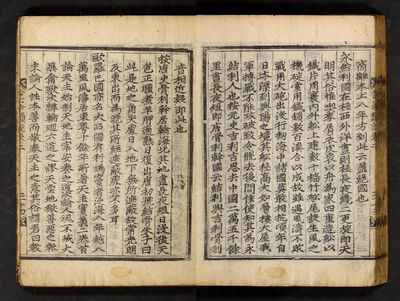
|
商。離本土八年。方到此云。蓋絶國也。 46. 永結利國。在極西外洋。晝則極長。夜纔二更。旋卽天明。其俗惟喫麥屑衣皮裘。以舟爲家。四重造船。以鐵片周裹內外。船上建數十檣竹。船尾設生風之機。碇索用鐵鎖數百湊合以成。故雖遇風濤不敗。戰用大砲。出沒行劫。海中諸國。莫敢相抗。頃年。自日本漂到興陽之境。其船極高大。如層樓大屋。我軍搏戰。不能攻破。致令脫去。後問倭使。知其爲永結利人也。按元史。吉利吉思去中國二萬五千餘里。晝長夜短。卽唐骨利幹國云。結利與吉利骨利音相近。疑卽此也。 47. 按唐史。骨利幹居翰海北。其地晝長夜短。日沒後天色正曛。煮羊胛適熟。日復出。唐初。號結骨。朱子曰。此是地之角尖處。日入地下。無所遮蔽。故常光明。及東出而爲曉。其所經遮蔽處。亦不多耳。 48. 歐羅巴國。亦名大西國。有利瑪竇者。泛海八年。越八萬里風濤。居東粤十餘年。所著天主實義二卷。首論天主始制天地。主宰安養之道。次論人魂不滅。大異禽獸。次辨輪廻六道之謬。天堂地獄善惡之報。末論人性本善而敬奉天主之意。其俗謂君曰敎 |
(translation) |

|
化皇。不婚娶故無襲嗣。擇賢而立之。又其俗重友誼。不爲私蓄。著重友論。焦竑曰。西域利君以爲友者第二我。此言奇甚云。事詳見續耳譚。 49. 萬曆癸卯。余忝副提學時。赴京回還使臣李光庭,權憘。以歐羅巴國輿地圖一件六幅送于本館。蓋得於京師者也。見其圖甚精巧。於西域特詳。以至中國地方曁我東八道,日本六十州。地理遠近大小。纖悉無遺。所謂歐羅巴國。在西域最絶遠。去中國八萬里。自古不通中朝。至 大明始再入貢。地圖乃其國使臣馮寶寶所爲。而末端作序文記之。其文字雅馴。與我國之文不異。始信書同文。爲可貴也。按其國人利瑪竇,李應誠者。亦俱有山海輿地全圖。王沂三才圖會等書。頗采用其說。歐羅巴地界。南至地中海。北至冰海。東至大乃河。西至大西洋。地中海者。乃是天地之中故名云。 50. 異聞志云天下無處非鬼充塞無間。獨互人國白玉城。以白玉爲之。鬼不敢入。蓋鬼陰物。喜黑而惡白耳。有人至此城得其故。歸以白石繞屋爲墻。時河間多疫癘。獨其家無染者。今人用白堊塗門。亦其遺意也。按後漢書。西域大秦國。以石爲城。列置郵 |
(translation) |

|
亭。皆堊墍之云。互人。疑亦西域國名。 |
(translation) |
- ↑ also written as 吾盧, Yīwú 伊吾 or Yīwúlú 伊吾卢
- ↑ 新五代史, Book 74. "Appendix on Four Barbarians" (四夷附录), 3: 34 https://ctext.org/wiki.pl?if=en&res=626823&searchu=%E5%A4%9A%E9%9B%AA&remap=gb
- ↑ See https://en.wikipedia.org/wiki/Hami https://zh.m.wikipedia.org/wiki/仲云国
- ↑ 新五代史, Book 73. "Appendix on Four Barbarians" (四夷附录), 2: 14 https://ctext.org/wiki.pl?if=en&chapter=158998&remap=gb#p15
- ↑ 新五代史, Book 73. "Appendix on Four Barbarians" (四夷附录), 2: 15 https://ctext.org/wiki.pl?if=en&chapter=158998&remap=gb#p16
- ↑ Ibid.
- ↑ Ibid.
